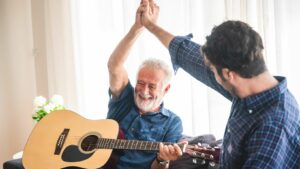As we age, staying active becomes increasingly important. Yet, it’s often overlooked, especially when it comes to the elderly. This article shines a light on the significance of engaging activities for seniors, right from the comfort of their homes.
From boosting mental health to improving physical well-being, these activities aren’t just about passing time. They’re about enhancing the quality of life for our elders. So, whether you’re a caregiver, a family member, or a senior keen on staying active, this guide’s got you covered.
Activities For Elderly At Home
 Activities at home are integral for seniors, enriching their lives and maintaining good health. This section expands on the underlying reasons for the importance of these activities and their impact on elders’ physical and mental health.
Activities at home are integral for seniors, enriching their lives and maintaining good health. This section expands on the underlying reasons for the importance of these activities and their impact on elders’ physical and mental health.
In an elderly person’s life, activities serve several crucial functions. First, they help maintain mental agility. For instance, puzzles and board games can stimulate the brain, keeping cognitive functions sharp. Second, activities foster social engagement. Arranging video calls, for example, allows seniors to stay connected, reducing isolation. Lastly, activities promote physical health. Simple exercises like stretching or gentle yoga can keep bodies fit and flexible.
The Impact of Activities on Elders’ Physical and Mental Health
Activities significantly impact both the physical and mental health of seniors. Physically, they help maintain muscle strength and bone health, mitigate the risk of falls, and enhance mobility. Consider daily walks or chair aerobics as examples. Mentally, activities stimulate the mind and boost mood. Engaging hobbies like knitting or reading not only keep the mind occupied but also provide a sense of achievement and satisfaction. Moreover, social activities reduce feelings of loneliness, offering a positive impact on mental well-being.
Types of Activities for Elderly Individuals at Home
Exploration of activities for seniors unveils a diverse repertoire. Distinctly, they nest into three categories: physical, cognitive stimulation, and social interaction activities.
 Physical activities imbue physical health and mobility. The richness lies in the variety and gentle nature of these workouts. Noteworthy examples include low-impact options such as chair exercises, dancing to music, and the gentle flow of Tai Chi. For more routine tasks, gardening and house chores also fall under this. Seniors derive satisfaction from accomplishment of these activities, resulting in jovial moods and physical vitality.
Physical activities imbue physical health and mobility. The richness lies in the variety and gentle nature of these workouts. Noteworthy examples include low-impact options such as chair exercises, dancing to music, and the gentle flow of Tai Chi. For more routine tasks, gardening and house chores also fall under this. Seniors derive satisfaction from accomplishment of these activities, resulting in jovial moods and physical vitality.
Maintaining mental agility is key for seniors. Cognitive stimulation activities present a robust technique for this. They cover a broad spectrum, for instance, solving puzzles like Sudoku and crosswords, or engaging in mentally stimulating games like chess. Add to that, hobbies like reading and writing also contribute to cognitive health. Even digital platforms like memory-enhancing gaming apps fall into this category. These activities foster mental agility, reduce feelings of loneliness and set a mood boost.
How to Choose Suitable Activities for Elderly at Home
Creating a supportive environment for seniors influences their ability for optimal engagement in activities at home. Understanding personal capabilities and safety considerations ensures the right choice of activities for elderly individuals.
 The facilitation of activities that coincide with the seniors’ personal interests often enhances their engagement. Personal interests may range from gardening to chess, but tailoring activities depends on the senior’s physical capabilities. If, for example, one can’t walk for extended periods, low-impact activities such as bird-watching or craft making may be ideal. Similarly, one with a keen interest in chess but with cognitive challenges may enjoy simplified board games. Overall, the aim in assessment is to strike a balance between interests and capabilities to stimulate both the mind and body meaningfully.
The facilitation of activities that coincide with the seniors’ personal interests often enhances their engagement. Personal interests may range from gardening to chess, but tailoring activities depends on the senior’s physical capabilities. If, for example, one can’t walk for extended periods, low-impact activities such as bird-watching or craft making may be ideal. Similarly, one with a keen interest in chess but with cognitive challenges may enjoy simplified board games. Overall, the aim in assessment is to strike a balance between interests and capabilities to stimulate both the mind and body meaningfully.
Safety Considerations and Precautions
Caregivers must consider safety as a primary factor when selecting home activities for seniors. This might involve modifications to make an environment secure, such as eliminating slip hazards in a gardening zone or ensuring light levels are adequate for reading. It also means closely monitoring physical activities to ensure there isn’t an overexertion that could potentially lead to injury. Another safety consideration is the regulation of online usage if a senior is engaging in virtual social activities, as it’s crucial to guard against internet scams and misinformation. Thus, strategically planned safety measures enable seniors to enjoy their favorite activities confidently and securely.



